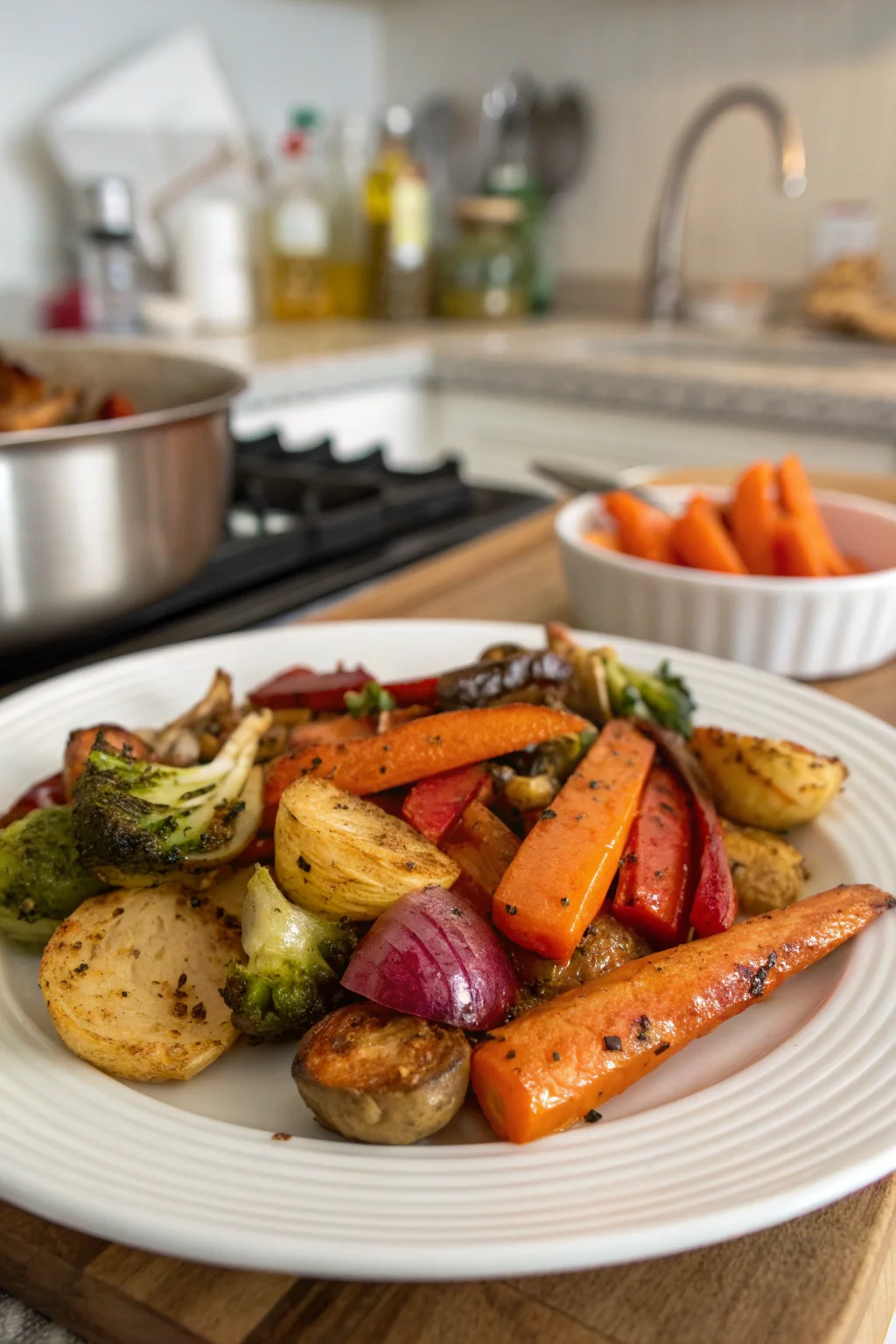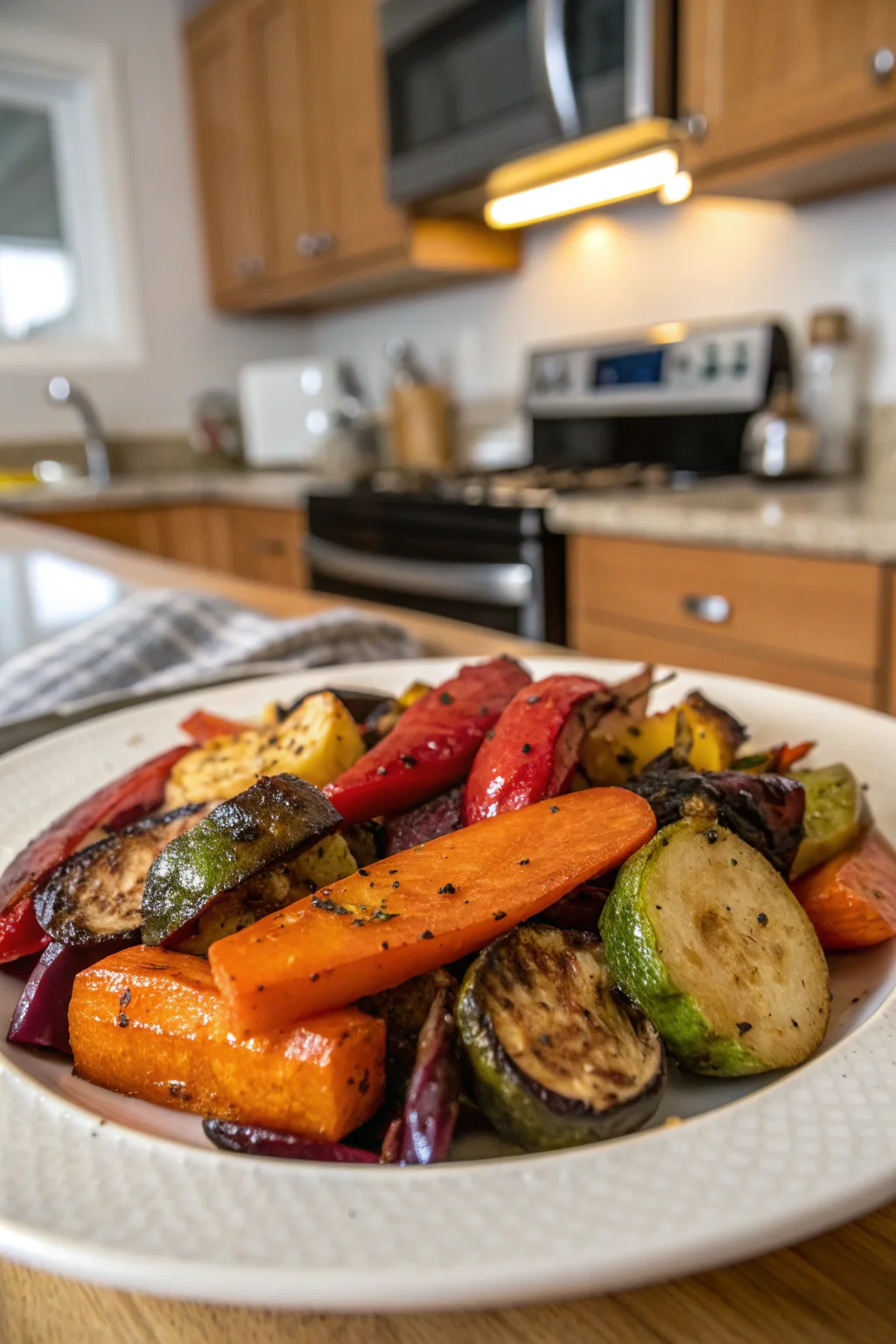Roasting vegetables is a simple yet transformative cooking method that brings out their natural sweetness and adds a delightful depth of flavor. Whether you’re a seasoned chef or a kitchen novice, learning how to roast vegetables for maximum flavor can enhance your meals and encourage healthy eating. This guide will answer your most pressing questions and provide practical tips to help you achieve perfectly roasted veggies every time.
Table of Contents
What Temperature is Best for Roasting Vegetables?
The ideal temperature for roasting vegetables is between 400°F and 425°F (200°C to 220°C). This range is hot enough to caramelize the vegetables’ natural sugars, enhancing their flavor and creating a crispy exterior while keeping the inside tender.
- Root vegetables like carrots and potatoes benefit from higher heat, around 425°F, for an even, crispy finish. The higher temperature helps in breaking down the cellulose and hemicellulose, the components responsible for the structural integrity of the vegetables, making them tender and flavorful.
- Delicate vegetables such as asparagus or tomatoes are best roasted at 400°F to prevent them from becoming too mushy. These vegetables have a higher water content and can easily become overcooked and lose their shape if the temperature is too high.
Remember to preheat your oven to ensure consistent cooking. Preheating is crucial as it ensures that the vegetables start cooking immediately, rather than steaming in a slowly warming oven, which can lead to sogginess. Adjust the temperature as needed based on your oven’s performance and the type of vegetables you’re roasting. Keep in mind that ovens can vary, and using an oven thermometer can help ensure accuracy. Learn more about roasting techniques here.
How Long Should I Roast Different Vegetables?
Roasting times vary depending on the type and size of the vegetables:
- Root vegetables like beets, carrots, and potatoes: 30–45 minutes. These vegetables are dense and take longer to cook through. To speed up cooking, consider parboiling them for a few minutes before roasting.
- Brassicas like broccoli and Brussels sprouts: 20–30 minutes. Cutting Brussels sprouts in half or quarters can help them cook more evenly and reduce bitterness.
- Soft vegetables like zucchini and bell peppers: 15–20 minutes. These vegetables cook quickly due to their high water content and can become mushy if overcooked.
- Leafy vegetables like kale: 10–15 minutes. Tossing kale with a little oil before roasting helps it become crispy and flavorful, almost like kale chips.
Cutting vegetables into uniform pieces ensures even cooking. Uneven pieces can lead to some bits being overcooked while others remain underdone. Check for doneness by piercing with a fork; they should be tender and easily pierced. Adjust time based on your oven and personal preference. If you prefer a more caramelized finish, try leaving them in a few minutes longer. Find more tips on roasting vegetables.
Should I Use Oil When Roasting Vegetables?
Yes, using oil is essential for roasting vegetables. Oil helps to:
- Enhance flavor: It carries seasonings and herbs, making the vegetables more flavorful. The fat in the oil helps dissolve and distribute the flavor compounds evenly across the vegetables.
- Promote even cooking: Oil ensures that the vegetables cook evenly and prevents them from drying out. It creates a barrier that locks in moisture, which is especially important for vegetables that have less natural moisture.
- Encourage caramelization: It assists in browning, contributing to the crisp texture. The Maillard reaction, responsible for the golden-brown crust, is enhanced by the presence of oil and heat.
Use a high-smoke-point oil like olive oil or avocado oil. These oils not only withstand high temperatures without breaking down but also add their own subtle flavors to the dish. Coat the vegetables lightly; about 1 to 2 tablespoons per pound is sufficient. Over-oiling can lead to greasy vegetables and hinder browning.
How Can I Season Roasted Vegetables for More Flavor?
Seasoning is key to flavorful roasted vegetables. Start with basic salt and pepper, then consider:
- Herbs: Rosemary, thyme, or oregano add aromatic notes. Fresh herbs can be added towards the end of roasting, while dried herbs can be used from the beginning.
- Spices: Paprika, cumin, or chili powder can create depth. Smoked paprika adds a pleasant smoky flavor, while cumin can give an earthy warmth.
- Finishing touches: A squeeze of lemon juice or a sprinkle of parmesan cheese enhances flavor. Acidic elements like lemon juice can brighten up the flavors, while cheese adds a savory umami note.
Toss vegetables with seasonings before roasting to ensure even coverage. To prevent spices from burning, you can add them halfway through the roasting process. Experiment with your favorite herbs and spices to find combinations you love. Don’t shy away from bold flavors; roasted vegetables can handle them well.
How Do I Prevent Roasted Vegetables from Becoming Soggy?

To prevent sogginess, follow these tips:
- Avoid overcrowding: Spread vegetables in a single layer on the baking sheet. Overcrowding causes steaming rather than roasting, preventing the desired caramelization.
- Use a hot oven: A high temperature helps evaporate moisture quickly, promoting a crispy texture.
- Pat vegetables dry: Remove excess moisture before roasting. This is particularly important for vegetables that have been washed or are naturally moist.
Consider using a baking sheet with a rim to allow hot air to circulate around the vegetables. This method ensures a crispy finish. Additionally, using parchment paper or a silicone baking mat can help prevent sticking without adding moisture. For more kitchen tips, check out our cooking basics.
Can I Roast Frozen Vegetables?
Yes, you can roast frozen vegetables, but they require some adjustments:
- Do not thaw: Roast them straight from the freezer. Thawing can lead to excess moisture and sogginess.
- Increase the temperature: Set your oven to 450°F to compensate for the extra moisture. The higher temperature helps evaporate water quickly and encourages browning.
- Add more time: Expect an additional 5–10 minutes of roasting. Check the vegetables halfway through and adjust as needed.
Frozen vegetables may not be as crisp as fresh, but they can still develop good flavor. Dry them with a paper towel after roasting to remove excess water. To enhance their texture, finish them under the broiler for a minute or two.
What’s the Best Way to Cut Vegetables for Roasting?
Cut vegetables into uniform sizes for even cooking. Here are some guidelines:
- Root vegetables: 1-inch cubes. Uniform cubes ensure that each piece cooks at the same rate.
- Broccoli and cauliflower: Florets should be similar in size. This prevents some pieces from being overdone while others are still firm.
- Zucchini and eggplant: Half-inch rounds or half-moons. These cuts allow for even cooking and a pleasant bite.
Larger pieces take longer to roast, while smaller ones cook faster and can become too soft. Experiment to find the size that provides your preferred texture. Consider the final presentation as well; varied shapes can make the dish more visually appealing.
Should I Stir Vegetables While Roasting?
Yes, stirring vegetables halfway through cooking ensures even browning and prevents sticking:
- Use a spatula: Gently toss the vegetables to flip them over. This helps expose all sides to even heat and prevents burning on one side.
- Do not over-stir: Limit to once or twice during roasting to maintain caramelization. Over-stirring can disrupt the browning process and cause moisture to release.
Stirring also redistributes oil and seasonings for consistent flavor. If using a mix of vegetables, check that none are sticking to the pan, as this can cause uneven cooking.
Can I Roast Multiple Vegetables Together?
You can roast different vegetables together if they have similar cooking times. Here’s how:
- Group by size and density: Pair denser vegetables like carrots with potatoes. This ensures they cook at a similar rate.
- Stagger start times: Add quicker-cooking vegetables like asparagus later. This method allows each vegetable to cook perfectly without overcooking the faster-cooking ones.
Ensure vegetables are spread in a single layer to prevent steaming instead of roasting. Adjust the oven racks if needed to accommodate different trays. Using separate trays for different vegetables can also help manage cooking times effectively.
How Do I Know When Roasted Vegetables Are Done?
Roasted vegetables are done when they are tender and golden brown:
- Visual cues: Look for caramelized edges and a golden color. Vegetables should appear slightly shriveled and browned.
- Texture: They should be fork-tender but not mushy. Overcooking can lead to a loss of flavor and texture.
Taste-test a piece for doneness. Adjust cooking time based on your preference for crispness or tenderness. Remember that vegetables will continue to cook slightly after being removed from the oven due to residual heat.
What Are Some Flavor Pairings for Roasted Vegetables?
Consider these popular flavor pairings:
- Carrots with honey and thyme: Sweet and herbaceous. The honey enhances the natural sweetness of the carrots, while thyme adds a subtle earthiness.
- Brussels sprouts with bacon and balsamic glaze: Smoky and tangy. The bacon adds a savory richness, and the balsamic glaze provides a sweet-tart finish.
- Sweet potatoes with cinnamon and nutmeg: Warm and comforting. These spices complement the natural sweetness of the sweet potatoes and add a hint of warmth.
These combinations enhance the natural flavors of vegetables and add variety to your meals. Feel free to mix and match different herbs and spices to create unique flavor profiles. Explore more vegetable recipes.
How Can I Store and Reheat Roasted Vegetables?
Store leftovers in an airtight container in the refrigerator for up to 4 days. Proper storage prevents the vegetables from absorbing other flavors from the fridge.
Reheat by:
- Oven: Warm them at 350°F for 10 minutes to retain crispness. The dry heat of the oven helps restore their original texture.
- Stovetop: Sauté in a pan over medium heat. This method can add a bit of extra crispness if you use a little oil.
- Microwave: Use short intervals, though this may soften them. While convenient, microwaving can lead to a less desirable texture due to steam.
Reheating in the oven or on the stovetop helps maintain texture better than a microwave. Consider adding a fresh squeeze of lemon or a sprinkle of herbs after reheating to refresh the flavors.
Wrap-Up
Roasting vegetables is an easy way to elevate their flavor and texture, making them a delicious addition to any meal. By mastering the basics of temperature, seasoning, and cooking time, you can create a variety of flavorful dishes. Experiment with different vegetables and seasonings to discover your favorite combinations. For more cooking inspiration, check out our recipes section.
For additional tips and recipes, visit Epicurious or Food Network.

